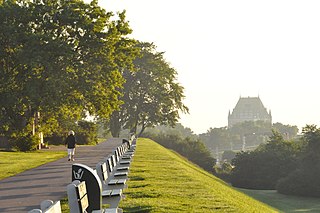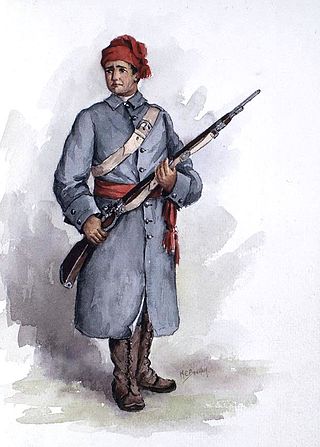
The Battle of Sainte-Foy sometimes called the Battle of Quebec, was fought on April 28, 1760 near the British-held town of Quebec in the French province of Canada during the Seven Years' War. It was a victory for the French under the Chevalier de Lévis over the British army under General Murray. The battle was notably bloodier than the Battle of the Plains of Abraham of the previous September, with 833 French casualties to 1,124 British casualties.

The Battle of the Plains of Abraham, also known as the Battle of Quebec, was a pivotal battle in the Seven Years' War. The battle, which began on 13 September 1759, was fought on a plateau by the British Army and Royal Navy against the French Army, just outside the walls of Quebec City on land that was originally owned by a farmer named Abraham Martin, hence the name of the battle. The battle involved fewer than 10,000 troops in total, but proved to be a deciding moment in the conflict between France and Britain over the fate of New France, influencing the later creation of Canada.

Louis-Joseph de Montcalm-Gozon, Marquis de Montcalm de Saint-Veran was a French soldier best known as the commander of the forces in North America during the Seven Years' War.

The Plains of Abraham is a historic area within the Battlefields Park in Quebec City, Quebec, Canada. It was established on 17 March 1908. The land is the site of the Battle of the Plains of Abraham, which took place on 13 September 1759, but hundreds of acres of the fields became used for grazing, housing, and minor industrial structures. Only in 1908 was the land ceded to Quebec City, though administered by the specifically created and federally-run National Battlefields Commission. The park is today used by 4 million visitors and tourists annually for sports, relaxation, outdoor concerts, and festivals.

Fort Carillon, presently known as Fort Ticonderoga, was constructed by Pierre de Rigaud de Vaudreuil, Governor of New France, to protect Lake Champlain from a British invasion. Situated on the lake some 15 miles (24 km) south of Fort Saint-Frédéric, it was built to prevent an attack on Canada and slow the advance of the enemy long enough for reinforcements to arrive.

Events from the year 1757 in Canada.

Events from the year 1758 in Canada.

Events from the year 1759 in Canada.

Events from the year 1760 in Canada.

General James Murray was a Scottish army officer and colonial administrator who served as the governor of Quebec from 1760 to 1768 and governor of Minorca from 1778 to 1782. Born in Ballencrieff, East Lothian, Murray travelled to North America and took part in the French and Indian War. After the conflict, his administration of the Province of Quebec was noted for its successes, being marked by positive relationships with French Canadians, who were reassured of the traditional rights and customs. Murray died in Battle, East Sussex in 1794.

Spruce beer is a beverage flavored with the buds, needles, or essence of spruce trees. Spruce beer can refer to either alcoholic or non-alcoholic beverages.

The 55th Regiment of Foot was a British Army infantry regiment, raised in 1755. After 1782 it had a county designation added, becoming known as the 55th (Westmorland) Regiment of Foot. Under the Childers Reforms it amalgamated with the 34th (Cumberland) Regiment of Foot to form the Border Regiment in 1881.

François-Gaston de Lévis, 1st Duke of Lévis, styled as the Chevalier de Lévis until 1785, was a nobleman and a Marshal of France. He served with distinction in the War of the Polish Succession and the War of the Austrian Succession. During the Seven Years' War, he was second-in-command to Louis-Joseph de Montcalm in the defense of New France and then, after the surrender of New France in 1760, he served in Europe. After the war, he was appointed Governor of Artois, and in 1783 he was made a Marshal of France.

The military of New France consisted of a mix of regular soldiers from the French Army and French Navy supported by small local volunteer militia units. Most early troops were sent from France, but localization after the growth of the colony meant that, by the 1690s, many were volunteers from the settlers of New France, and by the 1750s most troops were descendants of the original French inhabitants. Additionally, many of the early troops and officers who were born in France remained in the colony after their service ended, contributing to generational service and a military elite. The French built a series of forts from Newfoundland to Louisiana and others captured from the British during the 1600s to the late 1700s. Some were a mix of military posts and trading forts.

The Siege of Louisbourg was a pivotal operation of the Seven Years' War in 1758 that ended the French colonial era in Atlantic Canada and led to the subsequent British campaign to capture Quebec in 1759 and the remainder of French North America the following year.

The Battle of Bloody Creek was fought on December 8, 1757, during the French and Indian War. An Acadian and Mi'kmaq militia defeated a detachment of British soldiers of the 43rd Regiment at Bloody Creek, which empties into the Annapolis River at present day Carleton Corner, Nova Scotia, Canada. The battle occurred at the same site as a battle in 1711 during Queen Anne's War.
Benoni Danks was a New England soldier and politician who acted as the representative of Cumberland County in the Nova Scotia House of Assembly from 1765 to 1770. He is best known as the commander of Danks' Rangers, a unit which operated during the French and Indian War against the French.
Danks' Rangers was a ranger unit raised in colonial North America and led by Captain Benoni Danks. It was modeled on and often served alongside of the better known Gorham's Rangers. The unit was recruited in early 1756, during the early stages of the Seven Years' War / French and Indian War, from among men serving in two then-disbanding New England provincial battalions stationed in Nova Scotia. Raised to help protect the British garrison on the Isthmus of Chignecto and secure the area after the siege of Fort Beauséjour, their principle foes were Acadian and Mi'kmaq Indians conducting a low-level insurgency against the British authorities in Nova Scotia. Their primary area of operations was the northwestern portion of Nova Scotia and the north and eastern parts of what would later become New Brunswick. The unit averaged a little over one hundred men for much of its existence, although it seems to have been augmented to 125 for the attack on Havana in 1762. The company often operated in tandem with Gorham's Rangers, based out of Halifax, Nova Scotia, and after 1761, the two companies were combined into a Nova Scotia ranging corps, led by Major Joseph Gorham.

The Siege of Quebec, also known as the Second Siege of Quebec, was a French attempt to retake Quebec City, in New France, which had been captured by Britain the previous year. The siege lasted from 29 April to 15 May, when British ships arrived to relieve the city and compelled the French commander, Francis de Gaston, Chevalier de Lévis, to break off the siege and to retreat.
Thomas Oswald, younger brother of James Oswald of Dunnikier, was a British Army officer in the 18th century, engaged in the War of the Austrian Succession and Seven Years' War.












